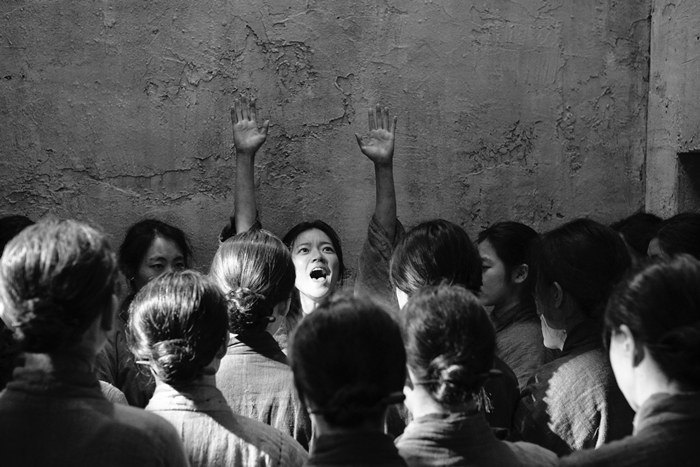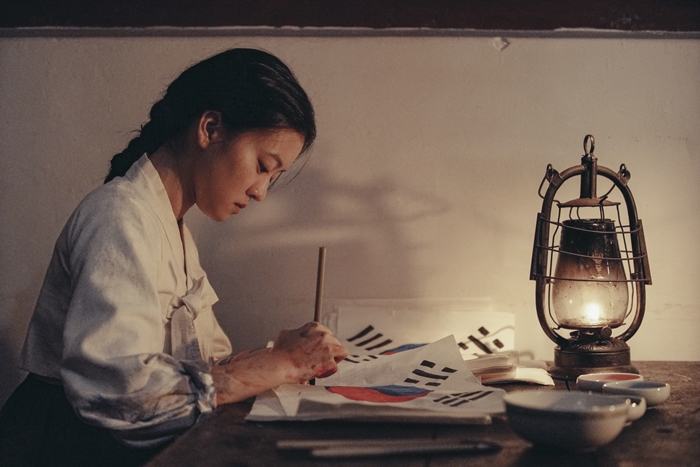
“A Resistance” chronicles the final year of the life of independence heroine and martyr Yu Gwan-sun (1902-20) when she was incarcerated at Seodaemun Prison in Seoul after taking part in the March First Independence Movement. This scene from the film shows Yu and other inmates shouting for national independence inside the prison.
By Lee Kyoung-mi and Yoon Sojung
Photos = Lotte Entertainment
Inside the small Cell No. 8 of Seodaemun Prison in Seoul, more than 20 women standing inside the small cold cubicle begin to take steps and sing “Arirang.” They are caught by Japanese police for shouting for Korea’s independence (“Daehan dongnip Manse," "대한독립 만세
") from Japan. The inmates include people from all walks of life including students, market vendors and tea shop staff. To prevent their legs from getting swollen inside such a tiny space, where they cannot lay down, they have to endlessly walk in circles.
On March 1, 1920, they again shout for their country’s independence in the same cell. Seodaemun Prison houses so many unknown Yu Gwan-suns.
From the film "A Resistance"
On March 1, 1920, they again shout for their country’s independence in the same cell. Seodaemun Prison houses so many unknown Yu Gwan-suns.
From the film "A Resistance"
Yu Gwan-sun (1902-20) was a heroine of Korea’s independence movement using nonviolent means who sacrificed her life for national liberation.
She remains a symbolic figure in the history of Korea’s independence movement. According to a survey conducted by the Ministry of Culture, Sports and Tourism this February, most respondents said they think of Yu first when remembering the March First Independence Movement.
“A Resistance,” a biographical film about the final year of Yu’s life, was released on Feb. 27. Also featured are her fellow inmates in the same room after the nationwide movement in 1919.
This year marks the centennial anniversary of the movement, making the movie’s release far more meaningful.
The film begins with Yu being taken to Seodaemun Prison for being a leading figure in the movement. She and other inmates stand up for each other despite experiencing all kinds of abuse, enduring their hardships with a smile.
A year after the movement, Yu again shouts for national independence while in prison. From Cell No. 8, her cry spreads throughout Seoul and turns into a large-scale protest. She is later locked in a narrow cave and subject to torture such as having her nails pulled out, but never gives in and keeps fighting for independence.
The film depicts Yu’s time in prison in black and white but switches to color when she reflects on her past and moments with her family.
Director Joe Mi-no said, "I decided to present the scenes in black and white to better portray facial expressions and the detailed emotions of the actors."
"By doing so, I hope that the film can give the audience more room for imagination."
"I had faith that we could gain wisdom and courage if we dug up buried history," he said in explaining why he made the film.
Meanwhile, the government on Feb. 26 bestowed on Yu the Republic of Korea Medal -- the nation’s highest honor -- on the movement’s centennial anniversary. She had earlier been awarded the Order of Independence Merit.

A scene from the film "A Resistance" shows Yu Gwan-sun drawing the Taegeukgi (Korean national flag) to participate in the independence movement.
km137426@korea.kr
Most popular
- Korea.net welcomes 2025 K-influencers, Honorary Reporters
- 2025 Honorary Reporter class pledges to spread 'real Korea' worldwide
- US urged to exempt tariffs on Korea in first '2+2' trade talks
- Korean culture festival in Cuba marks 1st year of bilateral ties
- Slew of festivals, events scheduled in downtown Seoul in May
